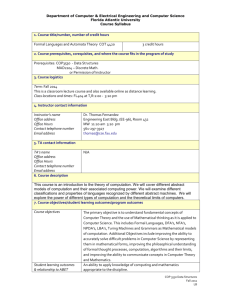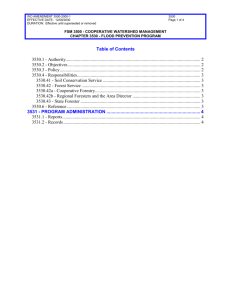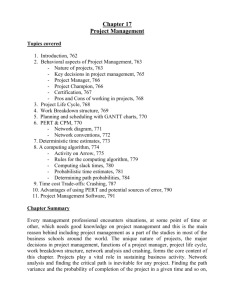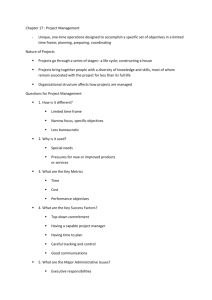BA 560 Management of Information System
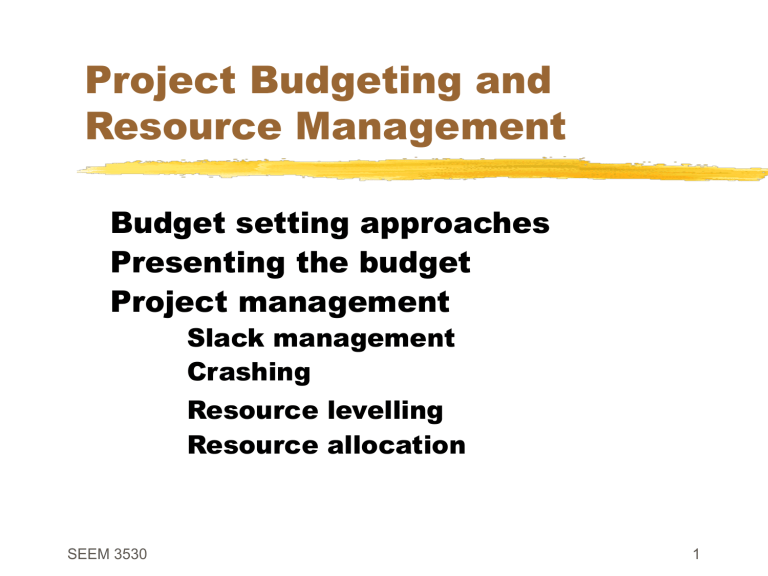
Project Budgeting and
Resource Management
Budget setting approaches
Presenting the budget
Project management
Slack management
Crashing
Resource levelling
Resource allocation
SEEM 3530 1
Introduction
Project Budget
specifies the activities and their costs so as to achieve its objective and fulfill all requirements to complete the project.
Three tiers of budgets:
Long-range, organization-level
Midrange, functional unit
Operational, project based.
SEEM 3530 2
Top-down Budgeting Approach
Long-range budget is developed by the top management, and then passed to the functional managers and project managers who will develop the functional and operational budgets.
Top-down approach to budget preparation:
Step Organizational level Budget prepared at each step
1 Top management Strategic budget based on organizational goals, constraints, and policies
2 Functional management Tactical budget for each functional unit
3 Project managers Detailed budgets for each project, including the cost of labour, material, subcontracting, overhead, etc.
SEEM 3530 3
Bottom-up budgeting
Project managers prepare his/her budget proposal that supports efficient and on-schedule project execution.
Functional managers prepare the budgets for their units, considering the resources required in each period of time.
To management streamlines and integrates the budgets from the low levels into a strategic long-range organizational budget.
Bottom-up approach to budget preparation
Step Organization level Budget prepared at each step
1
2
Top management
Project management
Setting goals and selection of projects
(a framework for budget)
Detailed budget proposals for projects including costs of material, labor, subcontracting, etc.
3 Functional management Midrange budget for each functional
4 Top management unit
Adjustments and approval of the aggregate long plan budget resulting from the process
SEEM 3530 4
Iterative budgeting
A combination of top-down and bottom-up budgeting
SEEM 3530 5
Presenting the budget
The budget generated is easier to understand and use if it is presented clearly and concisely.
The following recommendations can be adopted when preparing and presenting a project ’ s project
Incorporate a schedule showing the time that expenditure and revenues (if any) are expected to be realised.
Present the budget in quantitative, measurable units such as dollars or man-hours .
Define milestones in terms of achievements of goals and expenditures/revenues.
Use the budget as the baseline for progress monitoring
& control .
The budget should translate short-term objectives into work orders, purchasing orders , etc.
Breakdown the budget to individual units responsible.
SEEM 3530 6
Budget Management
The budget of a project specifies the scheduled expenditures and scheduled revenue as a function of time.
Two approaches are used to manage the project to meet budget constraints:
Slack management -- An approach that utilizes the slacks of activities to meet the organizational budget requirements.
Crashing -- An approach that attempts to shorten an activity duration by adding more resource, so as to achieve a trade-off between cost and time.
SEEM 3530 7
Slack management
Development of the budget of a project includes the derivation of the scheduled expenditures and the scheduled revenue as a function of time, subject to the time constraint and the total investment limit.
The approach of slack management attempts to utilize the slacks of the activities to re-schedule the project, so that the time and monetary constraints are satisfied.
SEEM 3530 8
Slack management
The process of selecting activities to reschedule the project will follow the following priority:
Non-critical activities that have free slack are the first candidates to be re-scheduled.
Non-critical activities that have total slack are the next candidates to be re-scheduled.
Finally, the critical activities are considered.
• Overall, our goal is to make the whole project to meet the time constraint while the monetary limit is satisfied.
SEEM 3530 9
Slack management -Example
Consider the example project, with the activities, durations and costs given below:
Activity Duration (weeks) Cost ($1,000)
E
F
G
C
D
A
B
7
4
5
8
7
5
3
5.7
6.1
7.2
Total = 31.0
1.5
3.0
3.3
4.2
SEEM 3530 10
Slack management
SEEM 3530
We have found that
(A,C,F,G) is the critical path, which has a length 22 weeks. The critical activities are A, C, F, and G, while activities B, E, and D have either free or total slack that can be used for budget planning.
11
Cash Flow
Let ’ s look at this project ’ s cash flow, assuming that, for budgeting purposes, the cost of each activity is evenly distributed throughout its duration.
In the next two tables, we look at the cash flow scenario for:
Early start schedule – Any activity will be started at its earliest start time. (Table 8-4)
Late start schedule – Any activity will be started at its latest start time. (Table 8-5)
SEEM 3530 12
SEEM 3530 13
SEEM 3530 14
Slack management
Figure 8.1 below depicts the cash flows for the early start and late start schedules.
Figure 8.2 below depicts their cumulative cash flows.
SEEM 3530 15
SEEM 3530 16
SEEM 3530 17
Slack management
From Figure 8-2 we can see that, if the total money allocated to the project is only
$4,913 for weeks 1 through 6, then during this period only a late start schedule is feasible.
Also, if the total allocation to the project is increased to $10,398 for the first 6 weeks, then an early start schedule will become feasible.
Any allocation between $4,913 and $10,398 will force a delay of certain non-critical activities.
SEEM 3530 18
Slack management
The approach of slack management is to properly adjust the timing for non-critical activities so that the limit of total monetary allocation is satisfied, while the project is not delayed.
An early start schedule will result in relatively high expenditures in the project ’ s earlier stages, while a late start schedule will result in relatively high expenditures in the project ’ s later stages.
SEEM 3530 19
Risk vs. Capital Commitment
Note that the choice between an early and a late start schedule affects the risk level associated with the project ’ s on-time completion.
Using a late start schedule means that all activities are started as late as possible without any slack to buffer against any uncertainty, increasing the probability of delays.
On the other hand, using an early start schedule requires an early commitment of money, which will mean additional cost if interest rate is taken into account.
SEEM 3530 20
Tradeoff Between Cost and Time
The approach of crashing is to reduce the duration of an activity by adding more resource, so as to achieve an optimal trade-off between cost and time.
Normally, for each activity, there is a time-cost curve, which represents the relationship between the time to complete the task and the associated cost.
SEEM 3530 21
Crashing
SEEM 3530 22
Crashing
The normal point gives the cost and the time involved when the task is performed in the normal way without extra resources such as overtime, special materials, or enhanced machine capacities to speed up the processing of the task.
The crash point gives the time and cost when the task is fully expedited; that is, no cost is spared to reduce its duration as much as possible.
SEEM 3530 23
Crashing
The time-cost curve may not be necessarily linear; it can take any form, even being a set of discrete points such as (L1, c1), (L2, c2), … ,
(Lm, cm).
Nevertheless, as an approximation, we sometimes assume that all intermediate timecost trade-offs are possible and that they lie on the line segment between the normal point and the crash point (that is, the time-cost curve is approximated as a continuous linear function).
With such an approximation, we need only estimate the normal point and the crash point to build the time-cost curve.
SEEM 3530 24
The Crashing Process
(1) Apply CPM to derive the normal schedule of the project, where each activity is performed at its lowest cost and at a normal duration.
(2) Identify the critical path, and select the critical activity that is least expensive for crashing. If more than one critical path exist, then a least expensive activity on each path should be selected for crashing so that all the critical paths will be shortened.
(3) Apply CPM again to derive the schedule of the project, where each activity is performed at the crashed cost and the crashed time as obtained in step 2 (if it has not been crashed, using its normal cost and time).
(4) Repeat Steps 2 and 3, until no more crashing to reduce the current critical path(s) can be performed.
SEEM 3530 25
Crashing - Example
SEEM 3530 26
Crashing Results
SEEM 3530 27
Crashing
The crashing process can continue until a
14-week span is obtained. At this point, two critical paths emerge: A-C-F-G, and
B-D-F-G.
The path B-D-F-G can be further shortened by crashing the activity B. But the path A-C-F-G can not be crashed any more.
Thus, the shortest possible duration of the whole project is 14 weeks.
SEEM 3530 28
Crashing – Cost vs. time tradeoff
The crashing process has revealed a relationship between the cost and the schedule of the project, which allows us to prepare our budget by considering the possible tradeoffs between cost and time.
SEEM 3530 29
Crashing - Example
• Suppose that a fixed overhead of $500 per week is charged during the project ’ s duration. Further, assume that the project is due in 18 weeks and that a penalty of
$1,000 per week is imposed starting from the 19 th week.
• The problem now is how to generate the best budget for the project so that the overall cost is minimal.
• Table 8-8 below summarizes the cost-time
SEEM 3530 function.
30
Crashing Example – Project costs
10,500
10,000
SEEM 3530 31
Crashing
• From Table 8-8, we can see that the minimum cost occurs at the project length of 19 weeks.
• That is, it is more economical to pay for a penalty of $1,000 and an overhead of $500 for a one-week delay than to pay $2,000 to crash the activity F to get an on-time schedule.
• Based on this result (a 19-week schedule), we can generate the budget for the project (including the costs for all activities and the schedules to pay for these costs).
• Figure 8-4 below graphically depicts the different cost components and the total cost as a function of its duration. Again, we can see that the 19-week schedule is the one with the lowest total cost.
SEEM 3530 32
Crashing
SEEM 3530 33
Resource Management
Resource leveling subject to project due date constraints
Resource allocation subject to resource availability constraints
SEEM 3530 34
Resource Management
Depletable resources -- Resources that are used up over time (e.g., a lump sum of money, raw materials, … etc.)
Renewable resources -- Resources that are available at the same level every time period (e.g., people, machines, … etc.)
Earlier, we mainly deal with budgeting and planning of depletable resources. Here we will consider the resource allocation problem with renewable resources.
Resource allocation for a project concerns with the trade-off between the cost of using resources, and the project schedule.
SEEM 3530 35
Example
Consider the example project as given in the
Table below:
SEEM 3530 36
Renewable Resource Usage
Consider the “ renewable ” resource (labor) used to perform the activities of the project. Table 9-1 gives the resource requirements:
SEEM 3530
196
37
Tracking Resource Usage
Gantt Chart -- A graph that depicts the activities performed on the vertical axis and their corresponding durations on the horizontal axis (a technique developed by Henry L. Gantt).
The Gantt chart for the early start schedule of the example project is shown in Figure 9-2a. The corresponding resource requirements are given in Figure 9-2b.
SEEM 3530 38
Gantt Chart and Resource Profile
- Early Start Schedule
SEEM 3530 39
Fluctuation in Resource Usage Level
The early schedule requires a high level of resource at the early stages. The requirement during the first 3 weeks is
17/5=3.4 person-days per day. The highest resource requirement is 17 person days per week, while the lowest resource requirement is 3 person days per week.
The fluctuation is 14 person-days.
SEEM 3530 40
Gantt Chart and Resource Profile
- Late Start Schedule
SEEM 3530 41
Resource Usage Levels – Late Start
Schedule
The late schedule moves the high level of resource requirement from weeks 1 through 3 to weeks 3 through 5. The highest resource requirement is 12 person days per week, while the lowest resource requirement is 3 person days per week. The fluctuation is 9 person days .
SEEM 3530 42
Resource levelling
Resource levelling is defined as the re-allocation of total or free slack in activities so as to minimize the fluctuations in the resource requirement profile.
When the total resource requirement for the project is fixed, a minimum fluctuation tends to reduce the peak resource requirement, and thus leads to more balanced requirements over all periods.
For renewable resource, a balanced resource requirement is the desirable solution.
For labor, this means a fairer working load distribution; This also means a lower costs for hire, fire, and training.
For materials, this means less effort in material planning and control, and also lower cost in inventory.
SEEM 3530 43
General Resource Levelling
Procedure
Calculate the average number of resource-days per period required by the project. (In the example, a total of 196 person-days are required. The average
= 196/22 = 8.9, or about 9 person-days per week, since the project duration = 22 weeks).
With reference to the early start schedule and noncritical activities, gradually delay activities one at a time, starting with those activities that have the largest free slack.
Select the schedule that minimizes the resource fluctuation (which has daily resource requirements close to the calculated average).
SEEM 3530 44
Resource levelling - Example
Apply the procedure of resource-levelling to the example project. Recall the results we have obtained by project scheduling (see the table below). We can see that activity E has the largest free slack (6 weeks).
SEEM 3530 45
Resource levelling - Example
The early start schedule is shown below.
The first step is to delay the start of E by 3 weeks until the end of activity B. This reduces the resource requirements from weeks 1 through 3 by 5 units. The resource profile is shown in the Table next.
SEEM 3530 46
Resource levelling - Example
The profile has a maximum of 13 person-days per week. Since the maximum occurs in weeks
4 and 5 and activity E can be delayed further, consider a schedule E starts after A is finished
(after week 5). The resource requirement profile in this case is shown in the Table next.
SEEM 3530 47
Resource levelling - Example
Now the profile has a maximum of 12 person-days per week. The minimum is still 3, given a fluctuation of 12-3=9.
SEEM 3530 48
Resource levelling - Example
The next candidate for adjustment is activity B, with a free slack of 2 weeks. However, delaying B by 1 or 2 weeks will only increase the load in weeks 4 and 5, resulting in a net gain zero.
Therefore, we proceed to the last activity with a positive free slack - activity D, which is scheduled to start at week 5.
Delaying D by 1 week results in the following resource requirement profile.
SEEM 3530 49
Resource levelling – Example
Minimum Fluctuation Schedule
Now the corresponding schedule is shown in Figure
9-4. Note now the fluctuation of person-days is
12-5 = 7, which is smaller than other schedules including the early start and the late start schedules.
SEEM 3530 50
Resource leveling subject to project due date constraints
Remarks
For small projects, the foregoing procedure works well but still cannot guarantee to find the optimal profile
(solution).
To improve on the results, a similar procedure can be activated by starting with the late start schedule and checking the effect of moving activities with slack back to the start of the project.
To obtain better solutions, a number of iterations (a loop of forward procedure and backward procedure) may be used.
SEEM 3530 51
§
12.2 Resource leveling subject to project due date constraints
SEEM 3530 52
Resource leve/ling vs. Resource
Limits
In some projects, it may be necessary to keep the maximum resource consumption below a certain ceiling (constraint) rather than merely leveling the resources (goal).
If a feasible schedule cannot be found by re-scheduling the non-critical activities, one or more critical activities would have to be re-scheduled to reduce the daily resource consumption to within limits.
SEEM 3530 53
Resource allocation subject to resource availability constraints
Many projects are subject to resource availability constraints.
For the example, if 17 or more person-days are available every week, then an early start schedule can be used to complete the project within 22 weeks.
If 12 person-days are available, then the project can still be completed in 22 weeks (by a late start schedule).
However, if the available person-days are 11 or less, then the completion of the project may have to be delayed.
How to minimize the project delay subject to the resource availability constraints is the concern of optimal resource allocation.
SEEM 3530 54
Resource allocation subject to resource availability constraints
To avoid a project delay in a low resource availability, the following techniques may be considered:
(1) Performing activities at a lower rate using available resource levels.
Assume 11 person-days are available for A and B per week, and the critical activity A requires 8 person-days while the non-critical activity B requires normally 4 person-days. Let A use 8 person-days, and then only 3 person-days left for B. Since B needs (3 weeks) x (4 person-days per week) = 12 person-days in total, it may be possible to schedule B to have (3 person-days a week) for 4 weeks, which also equals 12 person-days in total.
SEEM 3530 55
Resource allocation subject to resource availability constraints
(2) Activity splitting
It might be possible to split some activities into subactivities without altering the original precedence relations.
Then, complete some sub-activities first, and delay other sub-activities to later times when sufficient resource available.
(3) Modifying the network
Consider whether some precedence relations can be modified, so that conflicts in using resources are resolved.
(4) Use of alternative resource
Consider subcontractors.
If the above techniques cannot solve the problem, then one or more critical activities will have to be delayed, causing a delay in the completion of the project.
SEEM 3530 56
Resource allocation subject to resource availability constraints
To illustrate, consider the example project under a resource constraint of 11 person-days per week. Because A requires
8 person days, activity B can start only when A finishes.
The precedence relations force delays of D, as well as F and G. The new solution is shown below.
SEEM 3530 57
Resource allocation subject to resource availability constraints
It is interesting to note that when the maximum available resource reduces from 11 to 10 would not change the solution above.
If the maximum available resource further reduces to 9, the new solution is shown below (where C, D and E cannot be concurrently performed since they require a total of 10 person-days).
SEEM 3530 58
Resource Utilization
Resource utilization is defined as the proportion of availability that a resource is used.
For instance, in the example project, if 12 person-days are available each week and the total duration of the project is 22 weeks, then a total of 12 x 22 = 254 person-days are available. But only 196 person-days are used for the project, thus the resource utilization in this example is 196/254 = 0.74 = 74 %.
Resource leveling and resource allocation techniques can be used to achieve a higher level of resource utilization.
SEEM 3530 59
Multiple Resources
The analysis of resource allocation becomes much more complicated when several types of resources are used, the number of activities is large, and several projects compete for the same resources.
In real-life applications, the problem is usually solved with heuristics, using priority rules to make the allocations among activities.
SEEM 3530 60
Resource allocation heuristic
(1) First, a simple CPM analysis is used, assuming unlimited resource availability.
(2) Then, a check is made to see if the schedule generated is infeasible (the schedule is infeasible if its resource requirement exceeds its availability at any point of time).
(3) Infeasibilities are addressed one at a time, starting with the first activity in project network, and making a forward pass toward the last.
(4) A priority measure is calculated for each activity competing for the same resource. The activity with the lowest priority is delayed until sufficient resources become available.
(5) The steps (3)-(4) above are repeated, until all infeasibilities are resolved.
SEEM 3530 61
Priority rules for resource allocation
In the procedure above, a very important operation is the use of priority rules to determine the activities that should be delayed. How to design the priority rules depend on the situations and the experience and judgement of the decision maker.
SEEM 3530 62
Some common priority rules for resource allocation
Activity with the smallest slack.
Activity with minimum late finish time (as determined by
CPM analysis).
gives high priority to activities that should start early in the project.
Activity that requires the greatest number of resource units.
gives the highest priority to the activity that requires the maximum use of resource.
Activity that requires the smallest number of resource units.
Shortest activities.
Longest activities.
Hybrid : weighted sum of other priorities.
SEEM 3530 63
Summary
Project Management
Slack management
Crashing (Time vs. Cost tradeoff)
Resource levelling
Resource allocation
SEEM 3530 64
